How to store crickets!
One of the most common questions we get asked is "How do I store my crickets?" For many people it is their first time buying bulk crickets and they are unsure about how much room they will need, what to feed them and how to give them water. The good news is that all of these questions are easily answered and in no time at all you will have longer lasting, healthy cricketst!
What to put your crickets in:
The first thing you need to do before you get your crickets is make sure you have somewhere to put them. You need a container that is big enough to comfortably hold however many crickets you plan on keeping at once. This means the crickets need to have enough room to move around a little and aren't forced to stand on each other's backs. The size of the container you need also depends on the size of your crickets - 500 large crickets need more room than 1000 small for instance. Keep in mind that unless your pets are super hungry, your crickets are probably going to grow, so make sure your container has enough space to allow room for this. You can buy premade cricket keepers from pet stores for between $20 - $50 or with a little DIY you can easily make one yourself.
How to make your own cricket keeper:
There are a few options when it comes to DIY cricket keepers. If you are after something really quick and easy then an old aquarium or garbage can is perfect for you! Just be sure to check that the sides of your tank or garbage can are high enough that your crickets can't easily jump out. Aside from that, plastic storage containers make great homes for crickets! They come in all different shapes, colours and sizes but as long as you get one with enough room for the amount of crickets you have then you really can't go wrong.
Step 1 - Ventilation
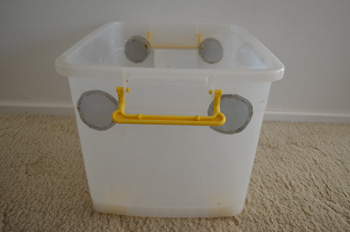
Now that you have your container you need to add some air holes. People usually do this one of two ways; drilling lots of small holes in the lid or cutting larger but fewer holes and covering them with mesh. Drilling lots of small holes works well to let air in however you should only use this option if you either have large crickets and very small air holes or are using a tall container so that your crickets can't reach the holes to squeeze out and escape. Coming Soon - A step by step guide on how to make airholes!
Step 2 - Housing
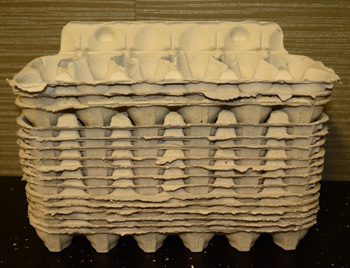
Once you have airholes taken care of, you need to add something for your crickets to live in. Old egg cartons or old toilet paper/paper towel rolls are perfect for using as cricket houses. Place as many egg cartons or cardboard rolls in the bottom of your container as you feel is necessary for the amount of crickets you have. You should try to place your egg cartons towards one end of the container, leaving room for a food and/or water dish at the other end. Don't stack them too close to the top of your container to avoid crickets jumping out when you take off the lid. You should throw out and replace your egg cartons/cardboard rolls when they get too dirty or if they get wet.
Step 3 - Food
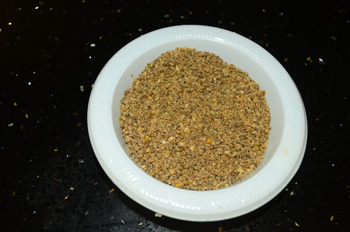
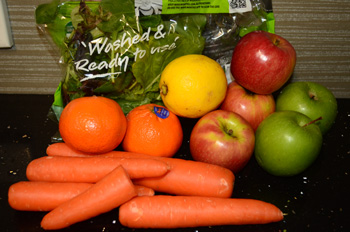
It is important that you feed your crickets correctly; not only to make sure that your crickets receive the proper high protein diet that they need but also so that your pet gets the most out of his/her meals! To provide your crickets with a balanced diet you should feed them both a variety of fresh fruit and vegetables such as carrots, lettuce, bok choy, apple, orange etc and also something that is high in protein such as crushed up cat or dog biscuits. If your crickets don't get enough protein in their diet they won't develop properly and may resort to eating one another. Place the crushed up food in a small plastic bowl and the food slices either in a free space on the floor of your container or in their own small bowl. Don't give your crickets more food than they can eat in a day or so. Too much food can start to attract flies and other unwanted insects or begin to go moldy if left too long.
Step 4 - Water
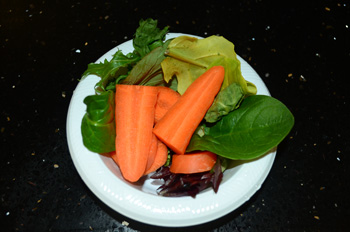
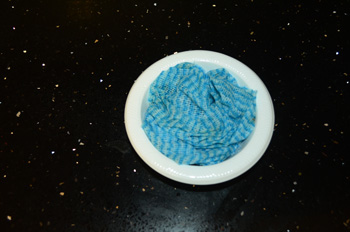
Another very important part of keeping crickets is providing them with plenty of fresh, clean water. There are a few ways that you can do this; Firstly you can simply give your crickets plenty of fresh fruit and vegetable slices each day that have a high water content. Things like carrot slices or lettuce leafs are a great option especially for the smaller crickets which can drown very easily, just be sure to replace the slices as necessary and remove any old pieces of food before it goes bad. The second option is placing a damp cloth or sponge in a shallow plastic dish and allowing the crickets to such the moisture from the cloth. This method is good for small - large crickets but just be mindful to check that the cloth is still moist each day and to either clean or replace it every few days. Lastly, if all of this sounds way too difficult, then you could try using water gel crystals. Simply throw a few cubes in a small dish as needed and the crickets will eat them without any possibility of drowning!
You should now have something that looks like this:
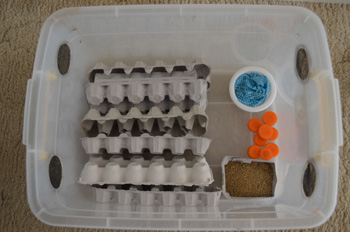
Don't worry if your cricket keeper doesn't look exactly the same as this one. If your crickets are healthy and not escaping then you're doing it right! How well your crickets do will depend on how much care you give them. Maintaining a regular feeding and cleaning schedual and providing your crickets with the right nutrients will help to give you healthy and happy crickets that your pet loves to eat!
Cricket Keeping Tips!
Ants can easily become a problem, especially if you have pinhead, tiny or small crickets. To avoid this, place your cricket container in a place that ants can't easily get to as well as regularly cleaning your cricket container of dead crickets and old food scraps.
Crickets are clean insects so you should aim to clean your container out at least once a week.
To have your crickets remain healthy and alive for as long as possible you should keep their container in a room that is between 20 - 25C. This will increase your crickets lifespan but also means they will grow slower and be a little less active.
Only large male crickets chirp but if the sound is becoming a problem for you, try placing them in a bathroom or garage (if it's not too cold) for the night and then put them in a warmer room again in the morning.